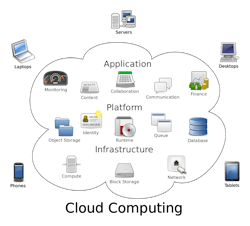It’s a fault not only of technology writers, but of people in general who make their living in the technology sector—we get so caught up in jargon that we don’t realize that not everyone we speak to really understands what we say.
With that in mind, when I ran across this explanatory list of cloud computing-related terms compiled by European Automation (a global supplier of industrial automation technologies), I saw the value in sharing the list.
Though the list is not exhaustive by any means, it does hit upon many of the cloud computing-related terms we are all hearing more and more.
Big Data: Essentially this is simply a huge collection of data. As a result of storage limitations, many companies are choosing to store their data in the cloud. The aim is to analyze and archive as much information as possible, to identify and exploit future trends.
Cloud Computing: Using groups of servers and software networks maintained by a third party to store and access data remotely rather than housing and maintaining the data yourself. This term can also apply to the use of computing resources managed by a third party.
Cloudbursting: If you run out of computing resources, you can spill the excess workload to an external cloud on an on-demand basis.
Disruptive Technology: An innovation that improves a product or service in unexpected ways. Cloud computing is often referred to as a disruptive technology because it has the potential to completely change the way IT services are procured, deployed and maintained.
Hybrid Cloud: A networking environment that combines aspects of both public and private clouds.
Infrastructure as a Service (IAAS): Cloud infrastructure services that deliver computer infrastructure. Rather than purchasing servers, software or network equipment, clients instead buy those resources as a fully outsourced service.
Internet of Things (IoT): Interconnectedness of different devices through the Internet. By connecting machines, a manufacturer can create intelligent networks able to communicate and control each other with reduced human intervention.
Platform as a Service (PAAS): A cloud platform service, whereby a provider delivers the operating system as a service over the Internet. Customized applications can be built and hosted outside of the customer's own system. Microsoft Azure is an example of a popular PaaS.
Public/Private Cloud Storage: When a service provider makes resources, such as applications and storage space, available to the general public over the Internet, free of charge or on a pay-per-usage model. The opposite of a private cloud implemented within the corporate firewall and under the control of the IT department.
Software as a Service (SAAS): Software applications delivered over the Internet by the provider, so that the applications don’t have to be purchased, installed or run on the customer’s computers. The service provider hosts the software so you don’t need to install it, manage it, or buy hardware for it. All you have to do is connect and use it.
Virtualization: The act of creating a virtual version of something, including but not limited to a virtual computer hardware platform, operating system, storage device or computer network resources. This process was, in many ways, the precursor to cloud computing in the automation sector.
Know of another term that should be included here? Send it to me with a brief description and I’ll update this article as needed.


